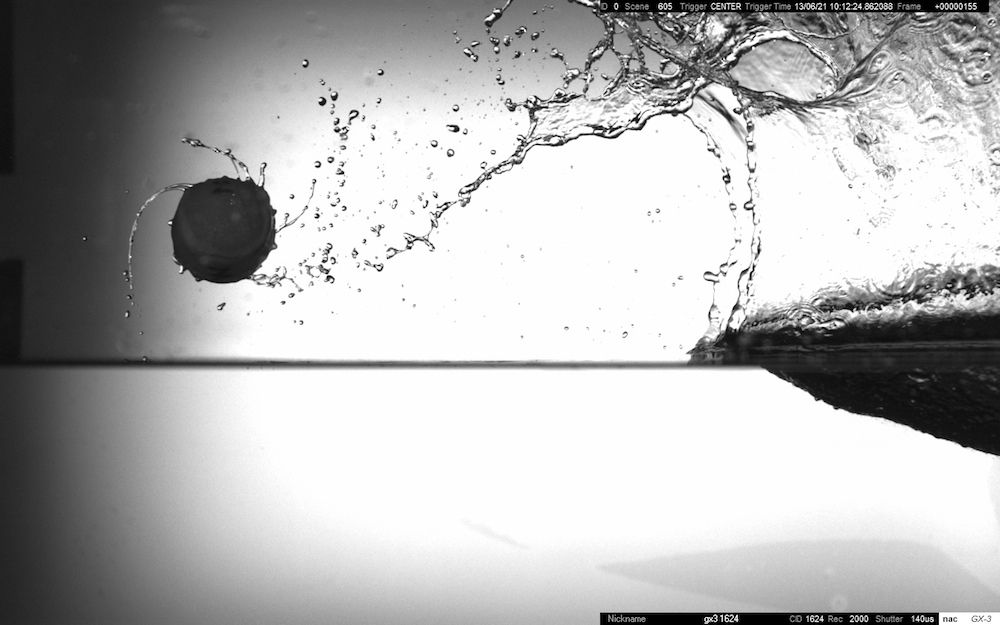US Navy Toys With Physics of Bouncy Balls

DENVER — A toy ball that skips on water far easier than the best skipping stone is the inspiration for a line of research that's caught the attention of the U.S. Navy.
The Waboba (named for its description, the "water bouncing ball") is a tennis ball-sized toy that can't bounce on land, but jumps like a champ in a lake, ocean or swimming pool. Brigham Young University physicist Tadd Truscott first noticed the toy while shopping with his son at a dollar store.
"We were like, 'Oh, we gotta try that,'" Truscott told reporters here Tuesday (March 4) at the March meeting of the American Physical Society. [Video: See the Water-Bouncing Ball]
The ball worked as advertised, skipping so readily across the water that it sometimes looks like it's rolling. For a physicist, the next natural question is: How? Now, Truscott is funded in part through the U.S. Navy's University Laboratory Initiative to answer that very question.
Skipping stones and bouncing balls
Like many people, Truscott and his son enjoy trying to skip rocks across smooth water. The physics of rock-skipping is fairly easy to explain: You need a flat rock thrown with the perfect rotation. This rotation gives the stone stability, allowing it to hit the water at the correct angle — 20 degrees for the maximum possible skips. The record in the Guinness Book of World Records for most skips was set in 2007 by Pennsylvania man Russell Byars, who skipped a stone a stunning 51 times.
Most people can skip a rock just a couple times, Truscott said, and a few can achieve 10 or so. But the Waboba takes much of the skill out of the equation, making it easy to get 30 or 40 bounces without much practice. Truscott compares it to a performance-enhancing drug for skipping.
Sign up for the Live Science daily newsletter now
Get the world’s most fascinating discoveries delivered straight to your inbox.
To find out why the ball bounces so easily, Truscott and his colleagues set up high-speed cameras and shot the balls out of potato guns, which use a length of pipe and a burst of air to propel a projectile. They found that the key is in the ball's elasticity. When the ball hits the water surface, it deforms, flattening like a pancake. The change in shape increases the surface area of the ball, increasing its lift force by a factor of four, which propels it out of the water cavity it creates as it hits the surface. [See Images of the Water-Bouncing Ball]
In fact, that cavity made by the ball forms slower than the ball moves, Truscott said, which creates a little water slope, much like a ski jump, that the ball can use on its upward climb.
The elasticity of the ball means the thrower doesn't have to worry about the rotation, as they would with the stone. You still have to get the correct speed and angle for a bounce, Truscott said, but even a "really sloppy" throw gets impressive results. Instead of an angle of 20 degrees, the Waboba can hit the water at up to 40 degrees and still bounce, he said.
Military toys
The question of the water-bouncing ball isn't purely academic — or purely fun. In Naval history, there are several examples of projectiles that skip over water rather than traveling through it or above it. For example, in the 1800s, Truscott said, sailors would angle cannonballs to skip over the water rather than lobbing them high through the air. These skipping cannonballs required less precision to make a hit, and tended to bounce up on decks, knocking off enemy sailors and breaking masts.
In the 1940s, the British developed the Wallis bouncing bomb, a surface torpedo that could be dropped from a plane and skipped across the surface of a lake to breach dams otherwise protected by underwater torpedo nets. The program was only rarely used but successful, breaching two dams in Germany's Ruhr Valley in 1943.
Truscott declined to say precisely what the U.S. Navy hopes to get out of his bouncing ball research, but said the military branch is interested in how elasticity affects motion in the water. Ships, for example, are more elastic than people realize. The project is generally useful for getting an object from one place to another without having all the information you need to calculate the height needed to land it in the right spot, Truscott said.
The researchers have now started building their own Woboba-like balls with accelerometers embedded to better study their motion as they skip. So far, they've studied only the first bounce, but they're now beginning to skip the balls in 150-foot-long (45 meter) tanks to see what happens across multiple bounces.
Follow Stephanie Pappas on Twitter and Google+. Follow us @livescience, Facebook & Google+. Original article on Live Science.

Stephanie Pappas is a contributing writer for Live Science, covering topics ranging from geoscience to archaeology to the human brain and behavior. She was previously a senior writer for Live Science but is now a freelancer based in Denver, Colorado, and regularly contributes to Scientific American and The Monitor, the monthly magazine of the American Psychological Association. Stephanie received a bachelor's degree in psychology from the University of South Carolina and a graduate certificate in science communication from the University of California, Santa Cruz.
Most Popular

